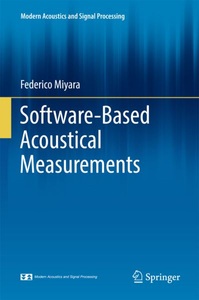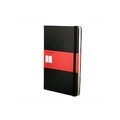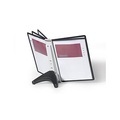





Chapter 1. INTRODUCTION 1.1 Acoustical measurements 1.2 Instantaneous and effective (RMS) value 1.3 Sound pressure level 1.4 Equivalent level 1.4.1 Stabilization time for Leq 1.5 Weighted levels 1.6 Exceedance levels 1.6.1 Stabilization time for exceedance levels 1.7 Spectrum analysis 1.7.1 Constant percentage spectrum analyzer 1.7.2 Line spectrum analyzer 1.7.3 Line spectrum and time-frequency uncertainty 1.7.4 Line spectrum and power spectral density 1.7.5 Band filters 1.7.6 Transient response of band filters 1.7.7 Parseval's identity 1.7.8 Effect of spectrum tolerance on Parseval's identity1.7.9 Weighted levels computed from one-third octave bands Chapter 2 UNCERTAINTY 2.1 Introduction 2.2 Resolution, precision, accuracy 2.3 Measurement method and procedure 2.3.1 Direct and indirect measurement methods 2.4 Measurement model 2.5 Uncertainty 2.5.1 Type A Uncertainty 2.5.2 Type B uncertainty 2.5.3 Expanded uncertainty 2.5.4 Combined standard uncertainty 2.6 Examples 2.6.1 Relationship between uncertainties in level and pressure 2.6.2 Uncertainty in the correction of environmental conditions 2.6.3 Uncertainty in the calculation of the equivalent level 2.6.4 Uncertainty in A-weighting computed from octave spectrum 2.6.5 Uncertainty in the measurement of sound transmission loss 2.7 Uncertainty and resolution 2.8 Uncertainty and systematic error 2.8.1 Additive systematic error 2.8.2 Multiplicative systematic error 2.8.3 Non linear systematic error 2.8.4 Uncorrected systematic errors 2.9 Chain calculation of uncertainty Chapter 3 DIGITAL RECORDING 3.1 Introduction 3.2 Digital audio 3.3 Sampling 3.4 Digitization 3.5 Signal-to-noise ratio 3.6 Low-level distorsion 3.7 Dither 3.8 Jitter 3.9 D/A and A/D conversion 3.9.1 Digital / analog conversion 3.9.2 Analog / digital conversion 3.10 Pulse code modulation (PCM) 3.11 Differential pulse code modulation (DPCM) 3.12 Delta modulation (DM) 3.13 Sigma-delta modulation (SDM) 3.14 Digital recording devices 3.15 Sound file formats 3.15.1 WAV format 3.15.2 FLAC format 3.16 Project files 3.16.1 AUP format 3.16.2 AU format 3.16.3 AUF format 3.16.4 External access to audio data 3.17 Recording and storage media 3.17.1 Hard disk 3.17.2 Flash memory 3.17.3 Optical discs 3.17.4 Digital audio tape (DAT) 3.18 File systems 3.18.1 FAT 32 3.18.2 NTFS 3.18.3 EXT4 3.18.4 HFS+ 3.18.5 UDF 3.19 Long-term preservation 3.20 Conclusion Chapter 4 DIGITAL AUDIO EDITING 4.1 Introduction 4.2 Audacity 4.2.1 Opening an existing file 4.2.2 Recoding sounds 4.2.3 Generating signals 4.2.4 Adding new tracks 4.2.5 Saving a project 4.2.6 Selection 4.2.7 Labels 4.2.8 Selection in the presence of labels 4.2.9 Calibration tone 4.2.10 FFT filters 4.2.11 Spectrogram and spectrum analysis 4.2.12 Noise removal Chapter 5 TRANSDUCERS 5.1 Microphones 5.2 Polarization 5.3 Preamplifier 5.4 Sound fields 5.4.1 Free field 5.4.2 Diffuse field 5.4.3 Pressure field 5.4.4 Stationary field 5.5 Microphones and sound fields 5.6 Frequency response 5.7 Directional response pattern 5.8 Noise 5.9 Distortion 5.10 Micromachined microphones 5.10.1 Frequency response 5.11 Audiometric earphones 5.12 Omnidirectional sources Chapter 6 DIGITAL SIGNAL PROCESSING 6.1 Discrete signals 6.2 Discrete impulse 6.3 A signal as its convolution with a discrete impulse 6.4 Discrete systems 6.5 Finite- and infinite-impulse-response systems 6.6 Difference equation of a discrete system 6.7 Frequency response of a discrete system 6.8 Z transform of a discrete signal 6.9 Z transform of a difference equation 6.10 Z transform of a convolution 6.11 Z transform and frequency response 6.12 Solution of a difference equation 6.13 Poles and stability of a discrete system 6.14 Inversion of a rational z transform 6.15 Continuous- to discrete-system bilinear conversion Chapter 7 BASIC ALGORITHMS FOR ACOUSTICAL MEASUREMENTS 7.1 Introduction 7.2 Opening a .wav file 7.3 Energy average and equivalent level 7.4 Calibration 7.5 Energy envelope 7.6 A weighting 7.7 Statistical analysis Chapter 8 SPECTRUM ANALYSIS 8.1 Introduction 8.2 Spectrum analysis paradigms 8.3 Digital filters 8.4 Discrete Fourier transform (DFT) 8.5 Fast Fourier transform (FFT) 8.6 Spectrum analysis with the FFT 8.6.1 Line spectrum analysis 8.6.2 The problem of frequencies close to Fs/2 8.6.3 The problem of subharmonic frequencies 8.6.4 Precise detection of pure tones 8.6.5 Windows 8.6.6 FFT band spectrum analysis 8.6.7 Spectral density and spectrum averaging 8.7 FFT filters 8.8 Some applications of the FFT 8.8.1 Determination of tonality 8.8.2 FFT convolution 8.8.3 FFT correlation 8.8.4 Critical band filters 8.8.5 Determination of transfer functions 8.9 Contrast of algorithms for use in measurments 8.9.1 International Standard IEC 61260 8.9.2 Contrasting algorithms 8.9.3 Procedure 8.9.4 Sound card calibration 8.9.5 Verification of the analyzer response 8.9.6 Contrast of different algorithms 8.9.7 Results 8.9.8 Conclusion Chapter 9 TESTING OF DIGITAL RECORDERS 9.1 Introduction 9.2 Specifications of the digital recorder 9.3 Tests 9.3.1 Frequency response 9.3.2 Noise 9.3.3 Linearity 9.3.4 Transient response 9.3.5 Uncertainty 9.3.6 Conclusions Further readings Appendix 1 Glossary and definitions on metrology Appendix 2 Fundamentals of Statistics Appendix 3 Statistical dispersion of the RMS value of a stationary noise as a function of the integrating time Appendix 4 Statistical dispersion of the RMS value of a non-stationary noise as a function of the integrating time Appendix 5 Statistical dispersion of percentiles Appendix 6 Envelope of a filtered noise Appendix 7 Transient response of a third-order bandpass filter Appendix 8 Combined uncertainty Appendix 9 Example calculation of uncertainty in the case of a non-linear systematic error Appendix 10 The sampling theorem Appendix 11 Structure of a FLAC file Appendix 12 Document type definition (DTD) for Audacity project files Appendix 13 Brief description of Scilab Appendix 14 Fast Fourier transform (FFT) Appendix 15 Parseval's identity and symmetry of the DFT Appendix 16 Spectrum of window functions Index... Mehr
Wir senden Dir eine Email, sobald das Produkt zum gewünschten Preis erhältlich ist.


 Preis-Alarm
Preis-Alarm



















